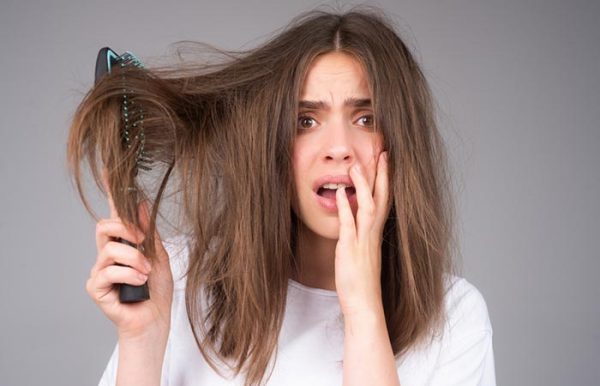
Frizzy Hair Treatments
Frizzy hair can be quite frustrating for many people, causing smooth hair to become tangled and messy when exposed to even a little bit of humidity or dryness. If you’re struggling with frizz or flyaways, it’s important to find the right treatment to help you control your hair and make it more manageable. In this article, we’ll delve into the causes of frizz, discuss effective frizzy hair treatments, and provide practical tips for managing your hair.
Causes of Frizzy Hair
Frizz happens when the outer layer of the hair, called the cuticle, gets raised and rough, allowing moisture to enter the hair strand and making it swell and get bigger. There are various factors that can lead to frizzy hair, such as:
Humidity: High humidity levels can cause the hair to absorb moisture from the air, resulting in swelling and frizz. This is a frequent occurrence in people with porous hair, as the higher moisture absorption worsens the issue.
Heat Damage: Excessive heat styling, such as blow-drying, flat ironing, or curling, can cause damage to the hair cuticle and remove its natural oils. This can lead to frizz and breakage, just like it would for any average person.
Dryness: Dehydrated hair lacks moisture and elasticity, which can lead to increased frizz. Various factors can contribute to this issue, including excessive washing, the use of harsh hair products, and exposure to environmental elements like sunlight and hard water.
Hair Texture: People with naturally curly or wavy hair may experience more frizz because their hair’s natural oils are not evenly distributed along the hair shaft. Curly hair has a tendency to be drier and more susceptible to frizz compared to straight hair.
Effective Treatments for Taming Frizzy Hair
Hydrating Shampoos and Conditioners: Opt for sulfate-free, moisturizing shampoos and conditioners that are specifically designed for dry or frizzy hair. Seek out ingredients that can provide hydration and smoothness to the hair cuticle, such as glycerin, coconut oil, and shea butter.
Deep Conditioning Masks: Weekly deep conditioning treatments can work wonders for your hair, providing nourishment and hydration. Seek out masks with ingredients that can strengthen the hair and minimize frizz, such as keratin, protein, and argan oil.
Leave-In Conditioners: For optimal hair care, it’s recommended to apply a leave-in conditioner or detangling spray to damp hair. This will help to provide the necessary moisture and protection against frizz. These formulas are designed to effortlessly smooth the hair cuticle, minimizing tangles and breakage.
Anti-Frizz Serums and Oils: Complete your styling routine by applying a small amount of anti-frizz serum or hair oil to give your hair a smooth and shiny finish. Pay attention to the mid-lengths and ends of the hair, being careful not to apply too much product near the roots as it can make the hair feel heavy.
Heat Protectant Sprays: Protect your hair from damage and reduce frizz by applying a heat protectant spray before heat styling. These sprays work to create a protective barrier that keeps your hair moisturized and prevents frizz and breakage caused by heat.
Professional Treatments: You might want to think about trying out professional treatments like keratin treatments or Brazilian blowouts. These treatments can work wonders in smoothing the hair cuticle and keeping frizz at bay for a good few weeks. These treatments function by infusing the hair with keratin proteins, which enhance and smoothen the hair shaft.
Tips for Keeping Your Hair Smooth and Frizz-Free
Avoid Excessive Heat Styling: Try to reduce the frequency of using heat styling tools and consider alternative methods like air-drying or heat-free styling techniques to protect your hair from damage and minimize frizz.
Protect Your Hair: Consider wearing a hat or scarf when the weather is humid or rainy to protect your hair from moisture and keep frizz at bay. Using a silk or satin pillowcase can help minimize friction and prevent frizz while you sleep.
Avoid Overwashing: It’s best to wash your hair no more than two to three times a week. This way, you can avoid removing the natural oils that keep your hair healthy and prevent dryness and frizz. Opt for a mild shampoo and lukewarm water to cleanse your hair.
Regular Trims: It’s important to schedule trims every six to eight weeks. This helps get rid of split ends and prevents them from causing frizz and breakage by traveling up the hair shaft.
Protective Hairstyles: Try out different protective hairstyles like braids, buns, or twists to keep your hair in check and reduce the effects of environmental factors that can lead to frizz.
Frequently Asked Questions About Frizzy Hair Treatments
1. What causes frizzy hair?
Frizzy hair occurs when the outer layer of the hair, known as the cuticle, becomes raised and roughened, allowing moisture to penetrate the hair shaft and causing it to swell and expand. Several factors can contribute to frizzy hair, including humidity, heat damage, dryness, and hair texture.
2. What are the best treatments for frizzy hair?
Effective treatments for frizzy hair include hydrating shampoos and conditioners, deep conditioning masks, leave-in conditioners, anti-frizz serums and oils, heat protectant sprays, and professional treatments such as keratin treatments or Brazilian blowouts.
3. How often should I use treatments for frizzy hair?
The frequency of treatments for frizzy hair depends on the severity of the frizz and the condition of your hair. Deep conditioning masks can be used once a week, while leave-in conditioners and anti-frizz serums can be used daily or as needed.
4. Can I make my own treatments for frizzy hair at home?
Yes, homemade treatments for frizzy hair can be made using natural ingredients such as coconut oil, avocado, honey, or yogurt. These DIY treatments can help moisturize and nourish the hair, reducing frizz and improving manageability.
5. Are there professional treatments available for frizzy hair?
Yes, salon treatments such as keratin treatments or Brazilian blowouts are available to help smooth the hair cuticle and reduce frizz. These treatments typically last for several weeks and can provide long-lasting results.
6. How can I prevent frizz in humid weather?
To prevent frizz in humid weather, wear a hat or scarf to shield your hair from moisture, use anti-frizz products such as serums or oils, and avoid overwashing your hair, as excessive washing can strip away natural oils and lead to dryness and frizz.
7. Can I use heat styling tools on frizzy hair?
While heat styling tools can help smooth frizzy hair, it’s essential to use them sparingly and always use a heat protectant spray to minimize damage. Opt for lower heat settings and avoid excessive use of flat irons or curling irons to prevent further damage and frizz.
8. Are there specific hairstyles that can help minimize frizz?
Protective hairstyles such as braids, buns, or twists can help minimize frizz by keeping the hair contained and protected from environmental factors. Additionally, hairstyles that minimize manipulation, such as low ponytails or buns, can help reduce friction and prevent frizz.
9. How can I maintain smooth, frizz-free hair between treatments?
To maintain smooth, frizz-free hair between treatments, use hydrating and nourishing hair care products, avoid overwashing and excessive heat styling, protect your hair from environmental factors, and schedule regular trims to remove split ends and prevent frizz.
10. Are there any side effects or precautions I should be aware of when using treatments for frizzy hair?
While treatments for frizzy hair are generally safe to use, some individuals may experience sensitivity or allergic reactions to certain ingredients. It’s essential to patch test new products and discontinue use if any adverse reactions occur. Additionally, always follow the instructions provided with the product and avoid overusing treatments to prevent product buildup or weighing down the hair.
Final Thoughts
Dealing with frizzy hair can be quite a challenge, but fear not! By implementing the appropriate treatments and taking good care of your hair, you can achieve a smoother and more manageable look. By gaining insights into the factors that contribute to frizz and incorporating proven remedies into your hair care regimen, you can effortlessly manage your locks and embrace your unique texture with self-assurance. With patience and consistency, you can conquer your hair care routine and bid farewell to frizz once and for all.


Leave a Reply